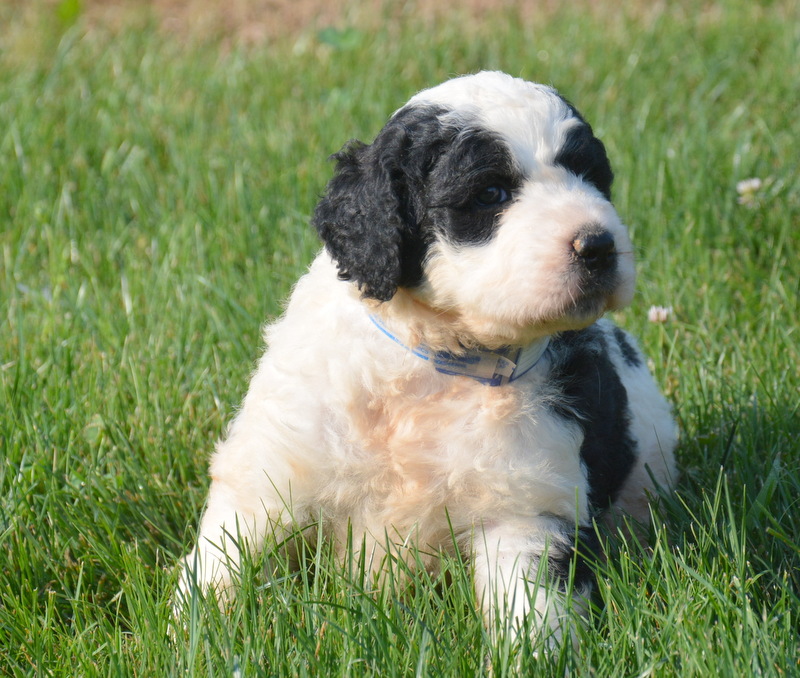Saint Berdoodle Dog Breed
Introducing the Saint Berdoodle to modern dog breeding marks a big step in creating large, gentle, and allergy-friendly pets. This crossbreed combines the kindness of a Saint Bernard with the smarts of a Standard Poodle. It’s a good choice for many homes since it doesn’t shed much and is very loving. However, each Saint Berdoodle can be different in health and behavior because of their mixed genes. Knowing a lot about their background and what they need is essential before you decide to get one.
This discussion will discuss what makes a Saint Berdoodle a special pet and what future owners should consider.
The Saint Berdoodle crossbreed has become popular because it meets specific needs. It is perfect for families or individuals with allergies due to its low-shedding coat. The breed is also known for being a great friend because of its loving nature. However, crossbreeds like the Saint Berdoodle have various health and behavior traits. Prospective owners should closely examine the dog’s family history and understand their care requirements. This will help them see if a Saint Berdoodle is the right fit for their home.
Key Takeaways
- Saint Berdoodle crossbreeds boast low-shedding coats, ideal for allergy sufferers.
- Their affectionate nature makes them excellent companions in many households.
- Understanding a Saint Berdoodle’s heritage and care needs is crucial for potential owners.
The Saint Berdoodle is an innovative mix, blending a Saint Bernard’s friendliness with a Poodle’s intelligence. This breed’s minimal shedding is a bonus for those with allergies. Yet, the variability in health and temperament due to their mixed lineage means it’s wise to research before adopting. They suit many homes with their low shed rate and affectionate demeanor. However, since each dog can differ, it’s essential to investigate their ancestry and care needs to ensure a good fit for your family.
Quick Facts
The Saint Berdoodle, a hybrid canine known for its friendly demeanor and hypoallergenic coat, is the result of a crossbreeding between a purebred St. Bernard and a purebred Standard Poodle, with its miniature counterpart originating from a union with a mini Poodle. This designer breed combines the gentle nature of Saint Bernard with the intelligence and low-shedding qualities of the Poodle.
Noted for their excellent temperaments, Saint Berdoodles are particularly good with children and are often sought after for their compatibility with family life. The mix exhibits hybrid vigor, typically resulting in a longer lifespan and fewer health issues than its purebred St. Bernard parent.
Generally, Saint Berdoodles are less prone to drooling and display a lower energy level than many breeds. Still, they remain more active than the purebred Saint Bernard, making them ideal walking companions.
Saint Berdoodle Dog Breed Pictures






Overview
Building on the foundation of quick facts, an in-depth overview of the Saint Berdoodle reveals a crossbreed that combines favorable traits from the Saint Bernard and the Poodle to form a companionable and versatile family dog.
As a mixed breed, the Saint Berdoodle is part of the growing popularity of designer dogs, purposefully bred for specific characteristics. They inherit the gentle and friendly demeanor of Saint Bernard alongside the intelligence and hypoallergenic qualities of the Standard Poodle, making them particularly suitable for families with allergy concerns. These dogs typically exhibit low to non-shedding coats, contributing to their hypoallergenic status.
Renowned for their exceptional temperaments, Saint Berdoodles are affectionate, good with children, and highly trainable. Their adaptability allows for comfortable apartment living despite their large size. Additionally, they benefit from hybrid vigor, often resulting in a longer life expectancy and a predisposition for good health.
With a generally low-energy nature, the Saint Berdoodle is an ideal pet for those seeking a calm and loving companion.
Poodle and a Saint Bernard Unique Blend of Traits

Saint Bernard stands out as a designer dog by combining the best qualities of the Saint Bernard and the Standard Poodle. This creates a flexible and loving pet. These large dogs are known for their gentle nature, combining Saint Bernard’s friendliness with the Poodle’s smarts, also known for causing fewer allergies because of their coat.
| Trait | Saint Bernard | Standard Poodle |
|---|---|---|
| Size | Big and strong | Gracefully medium to big |
| Coat | Thick, varying lengths | Wavy, minimal shedding |
| Temperament | Good-natured, calm | Intelligent, easy to train |
| Adaptability | Fair | Excellent, adaptable |
| Health | Can have issues | Usually healthier |
When you mix these breeds, you get a Saint Berdoodle. They shed less, are easy to get along with, learn quickly, and are generally healthier. This makes them fantastic family pets and versatile enough to fit into many lifestyles.
Origins and Development

The Saint Berdoodle combines the strength of St. Bernard with the intelligence and low-shedding coat of the Standard Poodle. Breeders have focused on this mix to produce healthier, longer-living dogs through hybrid vigor. This dog has become increasingly popular among those who love dogs.
Understanding Saint Berdoodle helps to know about the personalities and physical characteristics of its St. Bernard and Poodle parents. The mix is generally healthier, avoiding many genetic problems. Key events in the breed’s history include the first deliberate breeding and the creation of specific breed standards for the Saint Berdoodle. Dedicated breeders have worked to perfect and spread awareness of the breed’s favorable traits. The demand for sociable large dogs suitable for people with allergies has increased Saint Berdoodle’s appeal.
Ancestral Breed Profiles
The Saint Berdoodle is a thoughtfully crafted mix, combining the robustness and friendly nature of the St. Bernard with the smarts and low-shedding coat of the Standard Poodle. The Standard Poodle brings its intelligence and low shedding to the table, enhancing the health and vitality of their offspring. St. Bernards contributes its impressive size and mild temperament, making the hybrid both large and approachable.
The result is a Saint Berdoodle that typically has a coat that doesn’t shed much is less prone to genetic health problems, and often lives longer than purebred St. Bernards.
This breed has become a favorite due to its ease of training, friendliness to those with allergies, and adaptability to living spaces, even apartments. The Saint Berdoodle’s gentle nature and intelligence make it an ideal companion for various owners.
Hybrid Vigor Benefits
Hybrid vigor, or heterosis, is an advantage seen in Saint Berdoodles. These dogs result from breeding a Saint Bernard with a Poodle. They benefit from a wider gene pool, which can lead to a healthier and more robust population. They often live longer and have fewer health problems typically seen in purebred Saint Bernards. The mix of genes in Saint Berdoodles gives them a solid foundation for good health.
The Poodle’s intelligence passed down to the Saint Berdoodle makes them easier to train. This breed fits well into family life due to their trainability and adaptability. They also tend to be calmer and don’t drool as much as their Saint Bernard relatives, which are practical benefits of their mixed breed status. These qualities make Saint Berdoodles popular choices for those looking for a dependable and family-friendly pet.
Historical Breeding Milestones
Saint Bernard dogs are a unique hybrid breed created by crossing St. Bernard dogs with standard poodles. This was done to bring together the best traits of both breeds. Breeders aimed to combine St. Bernard’s friendly demeanor and impressive size with the non-shedding coat and smarts of the Standard Poodle.
Mini Saint Berdoodles was created when breeders started using mini Poodles, appealing to those who prefer a smaller dog. A breeder named Dr. Nathan Crockett played a crucial role in perfecting the Saint Berdoodle, earning a reputation for his high-quality dogs.
These hybrids have gained recognition from various organizations that focus on mixed-breed dogs. This has solidified their place in the dog breeding world.
Standard Poodle and Saint Berpoo Dimensional Profile

The Saint Berdoodle combines the charm of the Saint Bernard and the intelligence of the Poodle, creating a hybrid that’s both smart and lovable. To ensure these dogs thrive, owners must know their size, weight, coat types, and the various stages they’ll go through as they grow. We’ll also discuss how much room they need to be happy and their typical lifespan.
- Size & Weight
- Coat Variations
- Growth Stages
- Space Needs
- Life Expectancy
The average size and weight of a Saint Berdoodle can vary, but they tend to be large dogs due to their Saint Bernard lineage. They require ample space to move around and enjoy life. When it comes to their coat, it can range from curly like a Poodle to straight like a Saint Bernard, and they come in various colors and patterns.
Understanding the growth and development stages of a Saint Berdoodle helps provide the proper nutrition and exercise. These dogs have specific space requirements due to their size; a small apartment might not be ideal. Lastly, with reasonable care, these dogs have a lifespan expectancy that can bring many years of joy to a family.
Average Size & Weight
Saint Berdoodles are among the larger hybrids, combining the Saint Bernard’s heft with the Poodle’s curls. These dogs can weigh between 110 and 200 pounds. They often hit the 60-pound mark at just four months old, showcasing their quick growth and hinting at their mature size.
Despite their size, Saint Berdoodles have a reputation for being gentle giants. They are affectionate and protective, making them great family pets. Despite their size, it’s not uncommon to see one of these large dogs seeking a cozy spot to cuddle or attempting to sit on your lap.
Typical Coat Variations
Saint Berdoodles are known for their large size and unique coats. These dogs come in various coat types, including wavy, curly, or straight. The texture can vary from the rough feel of a Saint Bernard to the plush curls akin to a Poodle.
Their coat colors include black, white, brown, and combinations, often with the distinctive Saint Bernard patterns. Coat length also differs, with some having short, easy-care fur and others sporting longer coats that require more grooming.
Each Saint Berdoodle has a distinct combination of these features, making every dog’s coat one-of-a-kind.
Growth & Development Stages
Saint Berdoodles undergo a remarkable transformation during their first year, quickly growing to their full adult size, usually within 12 to 18 months. They go through different stages of growth and development, marked by a sharp rise in height and weight.
It’s essential to give them the proper nutrition and take them for regular vet visits to support their rapid growth. Once they’ve gone through their initial growth phase, keeping them at a healthy weight and helping their muscles develop properly becomes the priority. This means sticking to a consistent exercise routine and ensuring a well-rounded diet.
Their mental and behavioral growth continues, and early socialization and training are crucial in shaping their personality. Watching for common health issues is essential to the breed as they age. Keeping their minds engaged is also necessary to prevent boredom and behavioral problems.
Space Requirements
Saint Berdoodles are large dogs that grow significantly and need enough room to thrive. They’re a cross between a Saint Bernard and a Poodle, and they need ample living space to move around comfortably. These dogs should have a big enough bed to stretch out in, and both the inside and outside of your home should give them plenty of room for exercise.
Wide pathways and doorways make it easier for them to get around, and it’s wise to have tall ceilings and door frames to suit their stature. This makes sure they can enjoy their home without feeling restricted.
Lifespan Expectancy
Saint Berdoodles typically live between 10 to 12 years. Their mixed-breed heritage can lead to a sturdier constitution and potentially longer life than purebred dogs.
Owners must provide a nutritious diet and regular physical activity that suits the breed’s requirements. Proper care, including grooming and regular vet visits, is critical to their well-being. These steps can help catch and prevent health issues early on.
Even though being a mixed breed can benefit their health, a Saint Berdoodle’s lifespan is also shaped by individual health and genetic factors.
Temperament Traits

Prospective owners need to understand a Saint Berdoodle’s behavior to see if they’re a good fit for their home and way of life. These big dogs have a personality shaped by their Saint Bernard and Poodle ancestors, which affects how they act around people and other pets. Here’s a closer look at what makes them who they are:
- Gentle Nature: Saint Berdoodles are known for their calm and loving demeanor, making them great companions. They’re big but have a heart to match, ideal for families looking for a patient and nurturing pet.
- Family Focus: These dogs thrive in a home environment where they can be part of daily activities. They bond closely with their human family, showing affection and loyalty that will make them a beloved household member.
- Social Needs: Interaction is key for Saint Berdoodles. They enjoy meeting new people and pets, which means regular walks and playdates are remarkable for their well-being. Keep them engaged socially to ensure they stay happy and confident.
- Protective Instinct: While gentle, they also have an instinct to guard their loved ones. This trait makes them attentive and alert, but they need the proper training to ensure their protective nature doesn’t lead to over-guarding.
- Ease of Training: With the right approach, these dogs can be trained effectively due to their intelligence and eagerness to please. Consistent, positive reinforcement methods work best to bring out their best behaviors.
Understanding these aspects of a Saint Berdoodle’s personality is not just about knowing what to expect — it’s about creating a strong, loving bond that benefits both the dog and the owner.
Gentle Giant Nature
Saint Berdoodles are loved for their gentle and friendly personality, making them great family companions. They do well in a caring home, showing patience and kindness as they grow. These dogs are naturally protective but remain approachable, especially around kids, where they offer a lot of patience. Training and socializing them well is critical to keeping their good temperament.
Caring for a Saint Berdoodle means meeting their significant grooming needs; their thick fur requires frequent brushing to avoid tangles. They also need enough exercise to stay healthy and happy, which also helps manage their hearty appetites.
Family-Oriented Behavior
Saint Berdoodles are known for their sweet nature and calmness, which make them ideal pets for families with children and other animals. They are consistently gentle, which has a calming effect on home life. These dogs are patient and supportive when interacting with kids, which helps everyone get along well.
Saint Berdoodles are also very loyal, often acting as vigilant protectors of their homes without being aggressive. Their ability to learn and follow commands makes them great candidates for the Canine Good Citizen program. This trainability and their obedient behavior make them valuable and beloved family members.
Social Interaction Needs
Saint Berdoodles are known for their love of family and require regular interaction with their owners to stay happy. These dogs bond deeply with their humans, so playing and doing activities together is essential. Starting socialization early helps Saint Berdoodles get along well with other animals and people. They thrive on companionship, which helps prevent unwanted behaviors and supports their instinct to protect healthily. Regular play and interaction contribute to their mental sharpness, emotional well-being, and stable personality, which are critical to a peaceful home life.
Interaction, companionship, and playtime are not just fun and games for Saint Berdoodles; they’re essential for their overall health. Engaging with these dogs helps them become well-behaved family members. These dogs become confident and content when included in family activities and introduced to new experiences. This makes them great pets and loyal protectors.
Protective Instincts
Harnessing a strong protective instinct, Saint Berdoodles often excel as both watchdogs and family guardians, displaying a natural caution around strangers that underscores their loyalty to their owners. These dogs may instinctively position themselves to shield their humans from unfamiliar individuals, a testament to their inherent protective nature.
It is imperative to utilize effective training techniques and behavior management strategies from an early age to ensure this instinct does not lead to overprotectiveness. Comprehensive socialization methods are vital in helping Saint Berdoodles distinguish between typical and threatening scenarios, fostering a well-adjusted temperament.
Such training enables them to balance their protective impulses with nurturing tendencies, especially in their gentle conduct with children.
Trainability Traits
Saint Berdoodles is known for its high trainability. They learn quickly thanks to their sharp minds and a strong wish to make their owners happy. These dogs pick up on things fast, partly because of their mixed breed’s health benefits, which also tend to increase their lifespan.
To make the most of their training, use positive reinforcement. This means giving treats or praise to reward desired behaviors and encouraging dogs to repeat those actions. Consistent use of commands and engaging their brains with puzzles and challenges are vital to training these intelligent dogs.
This approach helps Saint Berdoodles use their smarts and willingness to learn, resulting in a dog that listens well and follows instructions.
Saint Berdoodle Breed: Wellness Considerations
Caring for a Saint Berdoodle involves a comprehensive approach focusing on their well-being. This means addressing their physical health and ensuring their diet, exercise, and mental stimulation are taken care of.
For these friendly hybrids, it’s essential to:
- Implement health screenings to catch and treat breed-specific conditions early on.
- Create a nutrition plan that meets their energy and dietary requirements.
- Establish regular workout schedules to maintain their physical fitness.
- Introduce brain games and challenges to keep their minds sharp.
- Encourage early and ongoing social interactions to support good behavior.
A Saint Berdoodle thrives on a holistic care regimen that prioritizes its unique needs. Regular vet check-ups can identify health issues before they become serious. A well-rounded diet provides the fuel they need for their active lifestyle. Daily exercise keeps them fit and happy, while mental exercises prevent boredom and stimulate their intelligence. Socializing them from a young age helps them become well-adjusted adults.
This approach nurtures their well-being and strengthens the bond between the pet and the owner.
Health Screening Importance
Routine health screenings are vital for spotting health issues early in Saint Berdoodles. This timely detection allows for immediate action and better control of their health. Catching a problem early means preventing or managing diseases before they become severe.
These screenings provide a thorough understanding of a dog’s health, critical for creating a care plan tailored to each Saint Berdoodle. This mixed breed needs to combine knowledge of their genetic risks with their current health to keep them well and potentially extend their life.
Diet and Nutrition Essentials
A well-planned diet full of nutrients is critical for Saint Berdoodle’s health. Puppies especially need a balanced diet to help them grow and avoid future health issues.
Giant breeds like Saint Berdoodles can quickly become overweight if they overeat. Keeping their weight in check with good nutrition and regular exercise is essential.
Always ask a vet for the right food for your dog’s needs.
Don’t forget to keep plenty of fresh water available to keep your dog hydrated and healthy.
Exercise and Mental Stimulation
To keep Saint Berdoodles healthy and entertained, giving them daily exercise and brain games is essential. Consistent physical activity helps manage their weight and boosts their health. Mixing up their exercise with different outdoor activities is a smart move.
Enrichment toys are vital for keeping their brains sharp, like puzzles that test their thinking. Training routines provide physical and mental challenges, improving obedience and strengthening their minds.
Including interactive play and regular walks is vital for meeting their exercise needs. It’s essential to offer a range of activities catering to their body and mind for their overall wellness.
Saint Berdoodles Essential Maintenance Routines
Looking after a Saint Berdoodle isn’t just about love and play—it’s about sticking to a routine that keeps them healthy and content. We’re focusing on how to meet their physical and emotional needs. Here’s what every Saint Berdoodle owner needs to know:
- Grooming: Keep their coat smooth and clean with regular brushing.
- Activity: These dogs have lots of energy, so they get plenty of exercise and play.
- Nutrition: Choose the food to help them grow strong and stay healthy.
- Veterinary Care: Regular check-ups with the vet will keep them in top shape.
- Social Skills: Help them get along with others by regularly meeting new people and pets.
These steps will help ensure your Saint Berdoodle lives fully and happily.
Regular Grooming Schedule
A consistent grooming routine is vital for your Saint Berdoodle to stay healthy. This should include regular brushing, baths, and haircuts.
Brushing their coat a few times a week is vital to prevent tangles and remove dead hair, which helps their coat stay healthy.
Bathing your dog every month with shampoo made for canines will keep their skin and fur in good shape.
Taking care of their teeth is as essential as coat care to ward off dental problems, which dogs often face. Brushing their teeth frequently and having vet check-ups will keep their mouth healthy.
You might need to seek a professional groomer’s help every few months to keep your Saint Berdoodle looking its best.
Exercise and Playtime for Puppy
Regular grooming is vital for your Saint Berdoodle’s health, focusing on their coat and teeth. But don’t forget about the importance of daily exercise and fun activities.
These dogs love a good stroll or a playful session, which helps them stay fit and mentally sharp. Mixing in some obedience training during play is a smart move. It keeps your dog’s brain working and strengthens your connection with them.
Interactive toys are great for keeping your Saint Berdoodle busy inside the house. If you have a yard, it’s great for them to run around and burn off energy.
Always watch them, especially around kids or other animals, because of their size.
Dietary Management
For large breeds like the Saint Berdoodle, it’s vital to have a diet plan that supports their health and matches their energy needs at every growth stage.
Working with a vet to create a custom diet ensures they get what they need from puppies to their senior years.
Sticking to a regular meal schedule is critical to managing their hearty appetites and preventing weight gain, which is a considerable risk for these dogs.
You might need to tweak their meals as they grow, especially if they have food sensitivities that require unique ingredients, such as venison or sweet potato.
Keeping a close watch on their eating habits and updating their menu as needed will help keep your Saint Berdoodle thriving.
Health Check-Ups
Regular veterinary check-ups are crucial for keeping Saint Berdoodles healthy. These visits can catch health problems early, critical for effective treatment. Vaccinations given during these appointments protect dogs from serious illnesses. Dental exams are also essential to prevent tooth and gum issues that can lead to more significant health problems. Yearly blood tests help monitor the dog’s health, spotting any issues promptly. It’s also important to check the dog’s weight and body condition to prevent obesity.
Saint Berdoodles should stay at a healthy weight for their size and breed. This helps prevent health problems related to being overweight. Regular vet visits are the best way to ensure your dog stays healthy and happy for years.
Socialization Practices
Start their socialization early to ensure your Saint Berdoodle grows into a friendly and well-behaved dog. Introduce them to different people, other pets, and new places while they’re young to help them become confident and calm.
Letting them meet a variety of individuals and animals helps them learn to handle new situations well. Set up playdates with other dogs to teach them good manners around their peers. Also, let them interact positively with kids and adults to build their good nature.
Regular training, rewards, and praise will keep their social skills sharp for life.
Mixed Dog Breed: Nutritional Guidelines
When feeding Saint Berdoodles, a balanced diet tailored to their significant, mixed breed needs is vital for their health and long life. Setting up a regular feeding routine and paying attention to specific dietary needs can make a big difference.
Here’s what owners need to know to ensure their Saint Berdoodle is getting the best nutrition:
- Providing a diet that promotes strong bones and healthy joints is vital.
- Be aware of any food sensitivities or allergies your dog might have and adjust their diet accordingly.
- Feeding your dog appropriately for their age helps keep them in good health.
- Stick to recommended guidelines for how often and how much to feed your dog.
- Understand the advantages and possible issues when it comes to supplements and treats.
Owners should focus on these aspects to help their Saint Berdoodles thrive.
Balanced Diet Essentials
For a Saint Berdoodle, a varied diet is vital. This should include fresh fruits, vegetables, lean proteins, whole grains, and good fats to cover all nutritional bases.
Hydration is also vital, as plenty of water supports their body functions and helps with digestion.
To avoid overfeeding, measuring their meals and monitoring their weight is wise.
Nutrient-rich foods are crucial for a robust immune system and good health. Reducing highly processed foods and extra sugars can keep their weight in check and lower the risk of health issues.
Constantly tailor your Saint Berdoodle’s diet to fit their age, activity, and health concerns.
Special Dietary Considerations
Saint Berdoodles, like all dog breeds, often need diets designed for their specific health concerns, which may include food allergies and sensitivities. A diet tailored for them might contain uncommon proteins and carbs, like venison and sweet potato, to help avoid adverse reactions.
Choosing the right food is more than dodging allergies; it’s critical to their well-being. Regular vet visits are vital for assessing their dietary requirements and adjusting their meals.
The right mix of nutrients is a big part of their health and supports an active, healthy life.
Feeding Schedule Recommendations
To keep a Saint Berdoodle healthy and content, it’s vital to have a feeding schedule that suits its size and energy. Ask a vet to help determine how often and how much your dog should eat, as this depends on their age, weight, and activity.
Berdoodle puppies need several small meals a day that are right for their age to help them grow.
Adult Saint Berdoodles usually do well with two meals a day. Spacing out meals can help avoid stomach problems.
Ensure the dog food is high-quality and has the suitable protein, fat, and nutrients for this breed’s needs.

